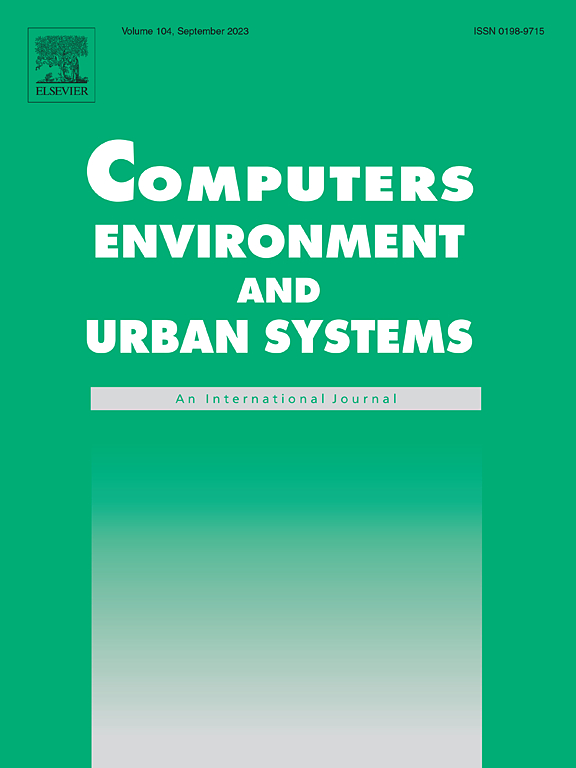A segmented approach to modeling building height: Delineating high-rise and low-rise buildings for enhanced height estimation
IF 8.3
1区 地球科学
Q1 ENVIRONMENTAL STUDIES
Computers Environment and Urban Systems
Pub Date : 2025-04-08
DOI:10.1016/j.compenvurbsys.2025.102287
引用次数: 0
Abstract
Understanding building height is imperative to the overall study of energy efficiency, population distribution, urban morphologies, emergency response, among others. Currently, existing approaches for modeling building height at scale are hindered by two pervasive issues. First, there is no consistent approach to quantify what a high-rise building is at a macro scale, leaving researchers unable to accurately compare results across geographies and domains. Second, high-rise buildings represent a small fraction of the built environment, implying data imbalance challenges that negatively affect current approaches. This is a problem of practical relevance since information on high-rise buildings is important for studies on urban heat islands, population dynamics, and pollution dispersion. Here, we introduce a novel approach to map building height which first identifies two distinct distributions within the built environment, with one being composed of low-rise buildings and one composed of high-rise buildings. We then develop an ensemble scheme where discrete specialist models are trained for each subset of low-rise buildings and high-rise buildings to infer building height from morphology features. For experiments mapping heights of 4.85 million buildings in Japan, we show an increase of 34 % in accuracy within error when compared to the current state-of-the-art when modeling high-rise buildings, which based on KNN experimentation we define as any building . Our findings show that such an ensemble framework outperforms the current state-of-the-art approaches, which is especially relevant in relation to inferring height for high-rise buildings, a prominent issue of existing approaches for mapping the built environment.
建筑高度建模的分段方法:描绘高层和低层建筑以增强高度估计
了解建筑高度对能源效率、人口分布、城市形态、应急响应等方面的整体研究至关重要。目前,现有的大规模建筑高度建模方法受到两个普遍问题的阻碍。首先,没有一致的方法来量化宏观尺度上的高层建筑,这使得研究人员无法准确地比较不同地域和领域的结果。其次,高层建筑只占建筑环境的一小部分,这意味着数据不平衡的挑战会对当前的方法产生负面影响。这是一个具有实际意义的问题,因为高层建筑的信息对于研究城市热岛、人口动态和污染扩散非常重要。在这里,我们引入了一种新的方法来绘制建筑高度,该方法首先在建筑环境中识别出两种不同的分布,一种由低层建筑组成,另一种由高层建筑组成。然后,我们开发了一个集成方案,其中为低层建筑和高层建筑的每个子集训练离散的专家模型,以从形态特征推断建筑高度。对于绘制日本485万幢建筑高度的实验,我们显示,与目前最先进的高层建筑建模相比,在3米误差范围内的精度提高了34%,基于KNN实验,我们将其定义为任何12米的建筑。我们的研究结果表明,这样的集成框架优于当前最先进的方法,这在推断高层建筑的高度方面尤其相关,这是现有的绘制建筑环境方法的一个突出问题。
本文章由计算机程序翻译,如有差异,请以英文原文为准。
求助全文
约1分钟内获得全文
求助全文
来源期刊

Computers Environment and Urban Systems
Multiple-
CiteScore
13.30
自引率
7.40%
发文量
111
审稿时长
32 days
期刊介绍:
Computers, Environment and Urban Systemsis an interdisciplinary journal publishing cutting-edge and innovative computer-based research on environmental and urban systems, that privileges the geospatial perspective. The journal welcomes original high quality scholarship of a theoretical, applied or technological nature, and provides a stimulating presentation of perspectives, research developments, overviews of important new technologies and uses of major computational, information-based, and visualization innovations. Applied and theoretical contributions demonstrate the scope of computer-based analysis fostering a better understanding of environmental and urban systems, their spatial scope and their dynamics.
 求助内容:
求助内容: 应助结果提醒方式:
应助结果提醒方式:


